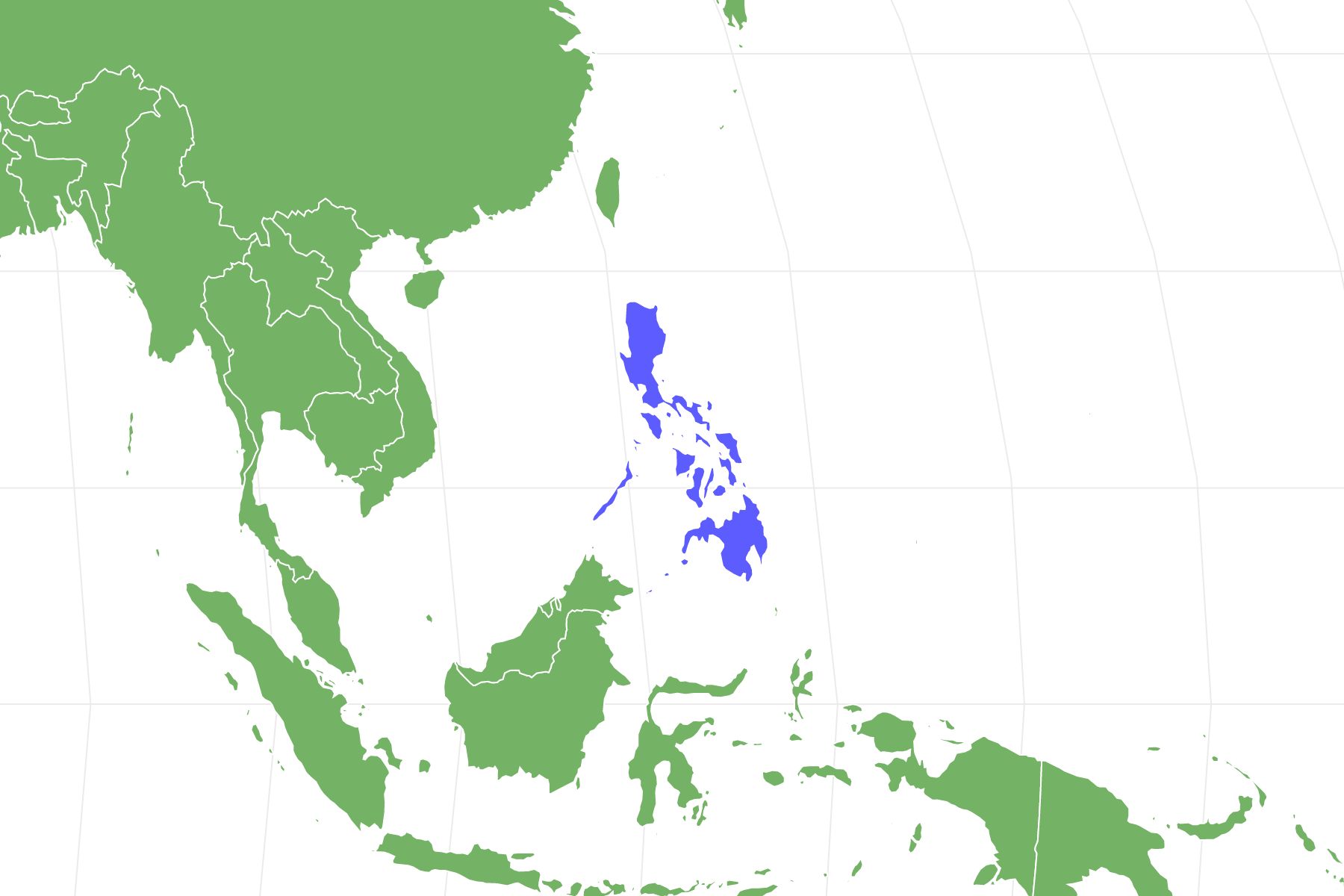They eat figs almost exclusively
Advertisement
Golden-Crowned Flying Fox Scientific Classification
- Kingdom
- Animalia
- Phylum
- Chordata
- Class
- Mammalia
- Order
- Chiroptera
- Family
- Pteropodidae
- Genus
- Acerodon
- Scientific Name
- Acerodon jubatus
Read our Complete Guide to Classification of Animals.
Golden-Crowned Flying Fox Conservation Status
Golden-Crowned Flying Fox Facts
- Name Of Young
- Pup
- Group Behavior
- Group
- Fun Fact
- They eat figs almost exclusively
- Estimated Population Size
- 10,000 – 20,000
- Biggest Threat
- Human hunters
- Most Distinctive Feature
- Soft golden cap
- Litter Size
- One
- Habitat
- Caves and forests
- Predators
- Reticulated pythons, eagles, humans
- Diet
- Herbivore
- Favorite Food
- Figs, leaves, some other fruits
- Common Name
- Golden crowned flying fox
- Group
- They live in large gatherings in the woods
View all of the Golden-Crowned Flying Fox images!
The golden-crowned flying fox has a wingspan of up to five-and-a-half feet.
This bat lives in the jungles of the Philippines, in colonies of up to 10,000 members. Though it has a large wingspan, this bat is small physically, with a body that measures between 7 and 11.4 inches long. The golden-crowned flying fox eats only figs and other fruit and ignores things such as blood and other food from mammals in its diet. They are unable to echolocate and instead must depend on sight for their navigation.

Incredible Golden-Crowned Flying Fox Facts!
- This bat is the largest bat in the world.
- The golden-crowned flying fox is a frugivorous species that eats some other plant life as well as fruit.
- The bat contributes to the reseeding of the forest by spreading seeds throughout.
- The golden-crowned flying fox eats a variety of leaves along with the figs.
- One species of the golden-crowned flying fox is extinct.
Scientific Name and Species
The scientific name of the golden-crowned flying fox is Pteropus jubatus, which comes from the Latin for having a crest or being crested. It gets this name because it is crested with a crown of golden hair. Two different golden-crowned flying foxes exist with similar names, one of which is the A. Jubatus jubatus and the other which has the name A. jubatus mindanensis. The bat is one of the largest on the planet, with a wingspan reaching 5.5 feet in length.
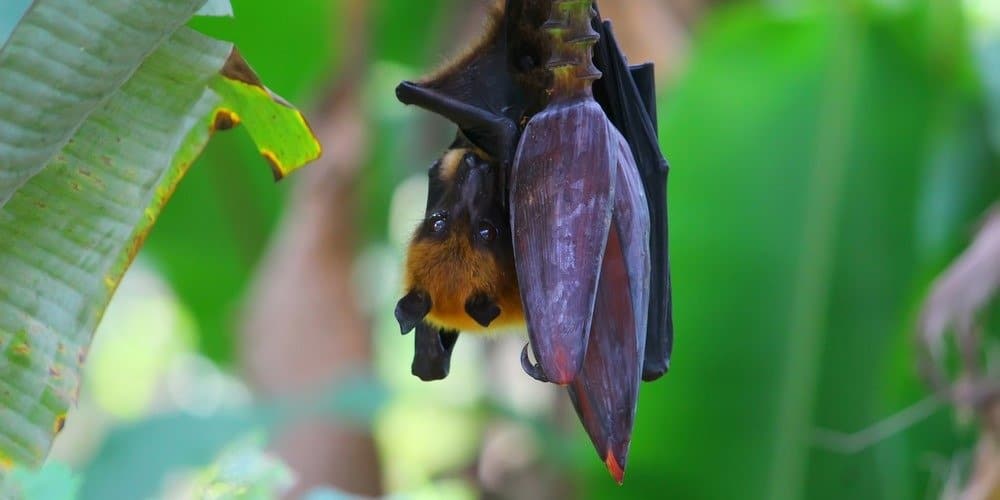
The golden-crowned flying fox is a large megabat with extra-long wings.
©OREON Digital Composition/Shutterstock.com
Evolution
Because of their tropical habitats that make the preservation of fossils difficult, there is very little fossil record of flying foxes. There are no known flying fox fossils from before the Holocene. It is believed that flying foxes diverged from a common ancestor with Rousettus 28 – 18 million years ago. Rousettus is a genus of old-world fruit bats referred to as rousette bats.
Appearance
The golden-crowned flying fox is a large megabat that eats figs as well as additional plants such as leaves from various plants. The bat is oversized, with wings stretching out as much as 8.5 inches from its body. The bat weighs about 3 pounds. Its long, skinny body stretches out between its wings and is covered with short hair colored both black and golden. The black hair covers its chest and back and the golden hair covers much of the flying fox’s head. Some parts of the animal are covered with maroon hair as well. It has small hands on the end of its two upper wingspans and two small feet on the base of its legs. Although they are protected, their conservation status is poor and the population size continues to shrink.
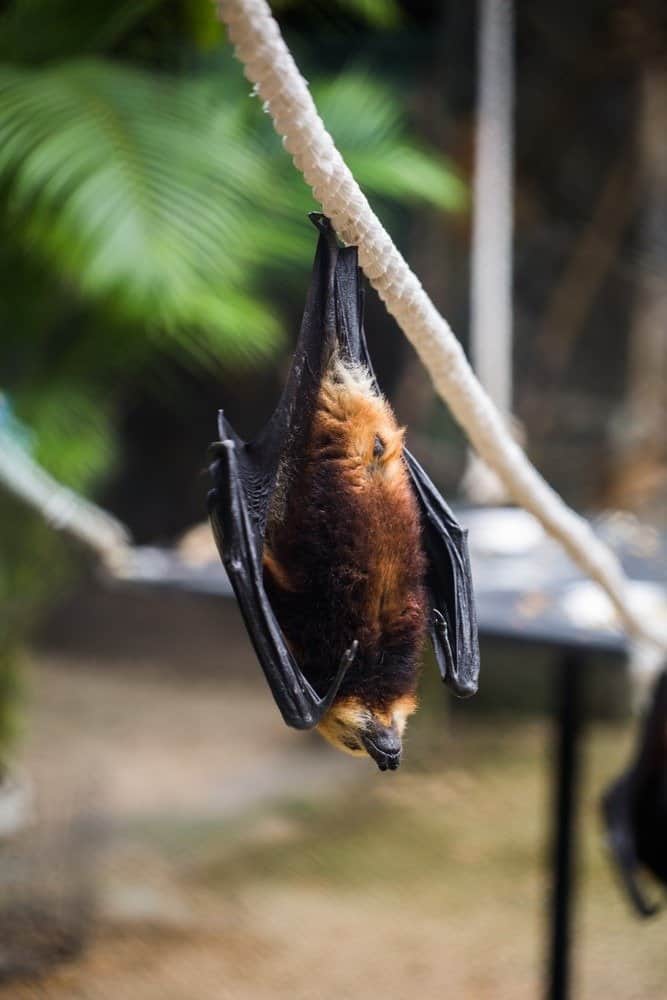
Golden-crowned flying foxes tend to live along rivers.
©Studio Peace/Shutterstock.com
Golden-Crowned Flying Fox Behavior
The golden-crowned flying fox tends to live along the rivers. Experts believe they do this to be able to find food to eat all of the time, as figs and plants with leaves are always available along the waterways. This way they can go up and down the rivers, searching for food as the night progresses.
While bats tend to limit themselves to mostly nighttime activities, making them nocturnal, they also participate in some activities in both the late afternoon and the early morning. Such activities include the elimination of waste and self-grooming activities. They may also engage in fighting and mating, usually in the morning.
Habitat

The golden-crowned flying fox lives only in the Philippines.
©Kasia Soszka/Shutterstock.com
The golden-crowned flying fox lives exclusively in the Philippines. They don’t appear naturally anywhere else in the world. They live in both deep caves and in the rainforest along or near waterways. They may live on one island and transfer to another island to forage, flying a great distance each time.
This bat often lives together with other giant megabats such as the large flying fox, foraging for food when it is time to fly. The species used to number in the tens of thousands, but they now number less than 5,000, with many groups even smaller than that. The bat is endangered now and may disappear if it is not conserved.
Diet

Golden-crowned flying foxes eat mostly figs and other regional fruits.
©Fajar Tri Amboro/Shutterstock.com
Most of what the golden-crowned flying fox eats is figs, but they will also consume leaves of various varieties when figs aren’t available or when the figs are thin. They may also consume regional fruits such as lamio, tangisang, puhutan, bankal, bayawak, and strangler figs.
Predators and Threats
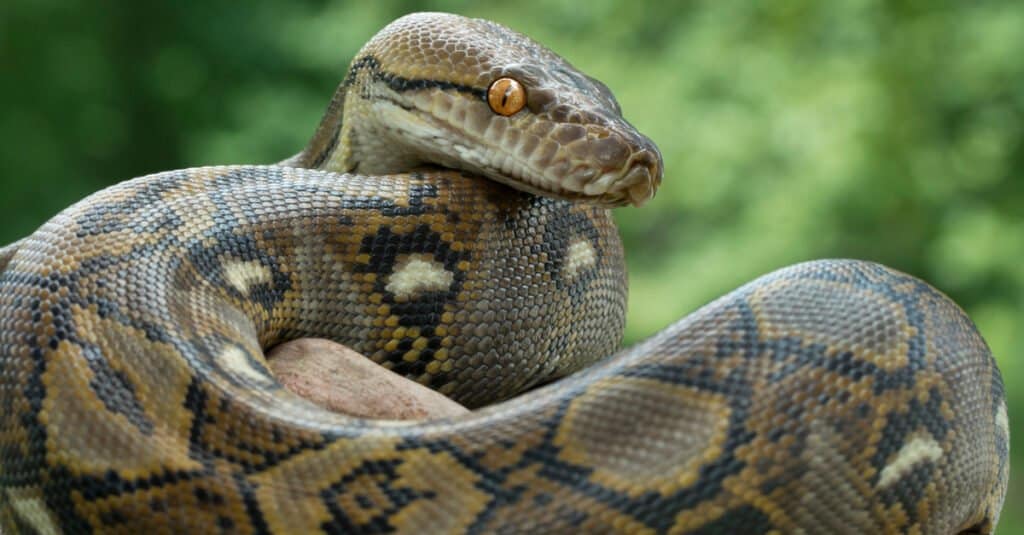
Reticulated pythons prey on golden-crowned flying foxes.
©Mark_Kostich/Shutterstock.com
The golden-crowned flying fox is preyed upon by several different predators including reticulated pythons, eagles, and humans.
Many of the golden-crowned flying foxes have been shot by human hunters to provide bushmeat for other humans. It is estimated that the population has been reduced by half since 1986.
These bats are protected in the Philippines, providing conservation for the future, but that typically makes very little difference to the ultimate survival of the bats and they continue to be endangered.
People continue to hunt them for food. Even where the hunting regulations are imposed the bats are disturbed by humans who want to see them in the daytime. This means that bats are continually disturbed during the daylight hours, making it difficult or even impossible for normal resting or breeding.
The current status of the golden-crowned flying fox is endangered.
Reproduction, Babies, and Lifespan
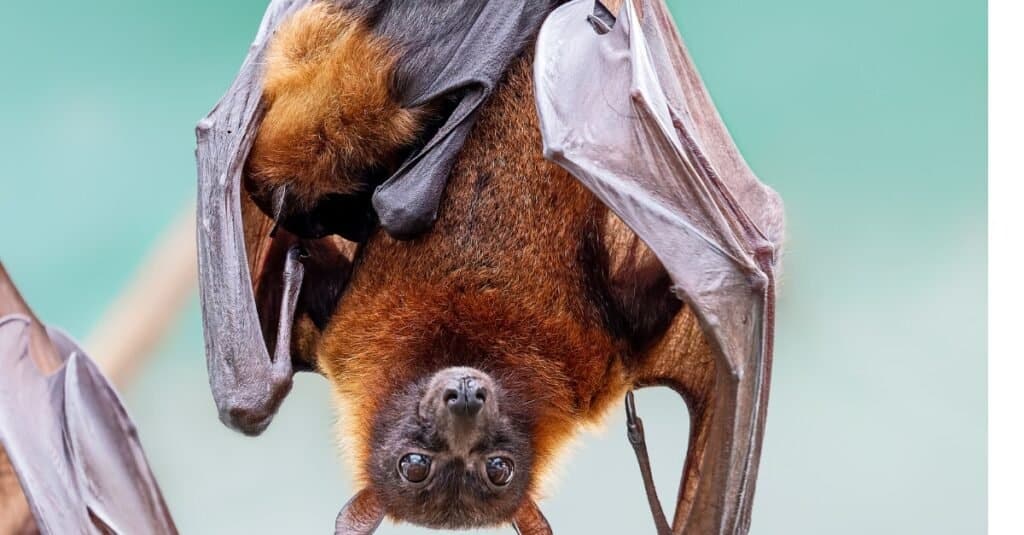
Baby flying foxes cling to their mothers until it is ready to be on their own.
©iStock.com/tane-mahuta
Not much is known about the reproduction of this bat. What is known is that the females of the species have a single baby, called a pup, once a year, in April, May, or June.
Males tend to be polygamous, with males mating as many females as possible during each breeding season. It isn’t known for sure how long the females are pregnant. Once the baby is born it clings to its mother and she keeps it cool by fanning it with her wing. The baby is ready to breed herself when she is about two years old.
Population
The population of this bat has dropped dramatically over the last 30 years. While they were well-known in the mid-80s, the bat population has dropped significantly due to the lack of a watchful society.
View all 170 animals that start with GGolden-Crowned Flying Fox FAQs (Frequently Asked Questions)
Is a Golden Crowned Flying Fox an omnivore, herbivore, or carnivore?
The golden crowned flying fox is frugivorous, which means that it eats fruits. It also eats leaves, so it is essentially an herbivore.
How big does a golden crowned flying fox get?
A golden crowned flying fox is one of the largest bats there is. They weigh in at about 3.1 pounds. They have huge wings, spreading as wide as a woman is tall, 5.5 feet.
Where does a golden crowned flying fox live?
These bats live only in the Philippines, dwelling in deep caves as well as nesting by the thousands in trees near the water.
What does a golden crowned flying fox eat?
The bats are mainly frugivorous, with the main food of a golden crowned flying fox consisting of mostly figs of different types. They also eat leaves of various trees when figs are not readily available.
Does a golden crowned flying fox really fly?
Yes, a golden crowned flying fox does fly. They are bats and they fly the same as other bats do. They do not use echolocation, instead of using only their sight to see where to fly.
Are golden crowned flying foxes dangerous?
Golden crowned flying foxes are not dangerous to humans, despite the fact that they are a very large type of bat.
What efforts are being made to protect and preserve the golden crowned flying fox?
There are laws in place in the Philippines that are intended to protect this megabat, but these laws are not very useful. People continue to ignore the laws, for the most part, causing the bats to get reduced even further and causing problems with its conservation. In some places, the bats are protected and it is observed, but because people continue to ignore many of the warning signs the bat population continues to shrink.
What Kingdom do Golden-Crowned Flying Foxes belong to?
Golden-Crowned Flying Foxes belong to the Kingdom Animalia.
What phylum do Golden-Crowned Flying Foxes belong to?
Golden-Crowned Flying Foxes belong to the phylum Chordata.
What class do Golden-Crowned Flying Foxes belong to?
Golden-Crowned Flying Foxes belong to the class Mammalia.
What family do Golden-Crowned Flying Foxes belong to?
Golden-Crowned Flying Foxes belong to the family Pteropodidae.
What order do Golden-Crowned Flying Foxes belong to?
Golden-Crowned Flying Foxes belong to the order Chiroptera.
What type of covering do Golden-Crowned Flying Foxes have?
Golden-Crowned Flying Foxes are covered in Hair.
What are some predators of Golden-Crowned Flying Foxes?
Predators of Golden-Crowned Flying Foxes include reticulated pythons, eagles, and humans.
What is the scientific name for the Golden-Crowned Flying Fox?
The scientific name for the Golden-Crowned Flying Fox is Acerodon jubatus.
What is the lifespan of a Golden-Crowned Flying Fox?
The average lifespan of the Golden-Crowned Flying Fox is unknown.
What is a baby Golden-Crowned Flying Fox called?
A baby Golden-Crowned Flying Fox is called a pup.
What is the biggest threat to the Golden-Crowned Flying Fox?
The biggest threats to Golden-Crowned Flying Foxes are human hunters.
How many Golden-Crowned Flying Foxes are left in the world?
There are between 10,000 and 20,000 Golden-Crowned Flying Foxes left in the world.
How many babies do Golden-Crowned Flying Foxes have?
The average number of babies a Golden-Crowned Flying Fox has is 1.
What is an interesting fact about Golden-Crowned Flying Foxes?
Golden-Crowned Flying Foxes eat figs almost exclusively.
Thank you for reading! Have some feedback for us? Contact the AZ Animals editorial team.
Sources
- The Sun, Available here: https://www.thesun.co.uk/news/12051892/photo-human-sized-bat-not-fake-not-seems/
- Fact Zoo, Available here: https://www.factzoo.com/mammals/giant-golden-crowned-flying-fox-fruit-worlds-largest-bat-endangered.html
- Bat Worlds, Available here: https://www.batworlds.com/giant-golden-crowned-flying-fox/
- All Thats Interesting, Available here: https://allthatsinteresting.com/giant-golden-crowned-flying-fox
- Wikipedia, Available here: https://en.wikipedia.org/wiki/Giant_golden-crowned_flying_fox

